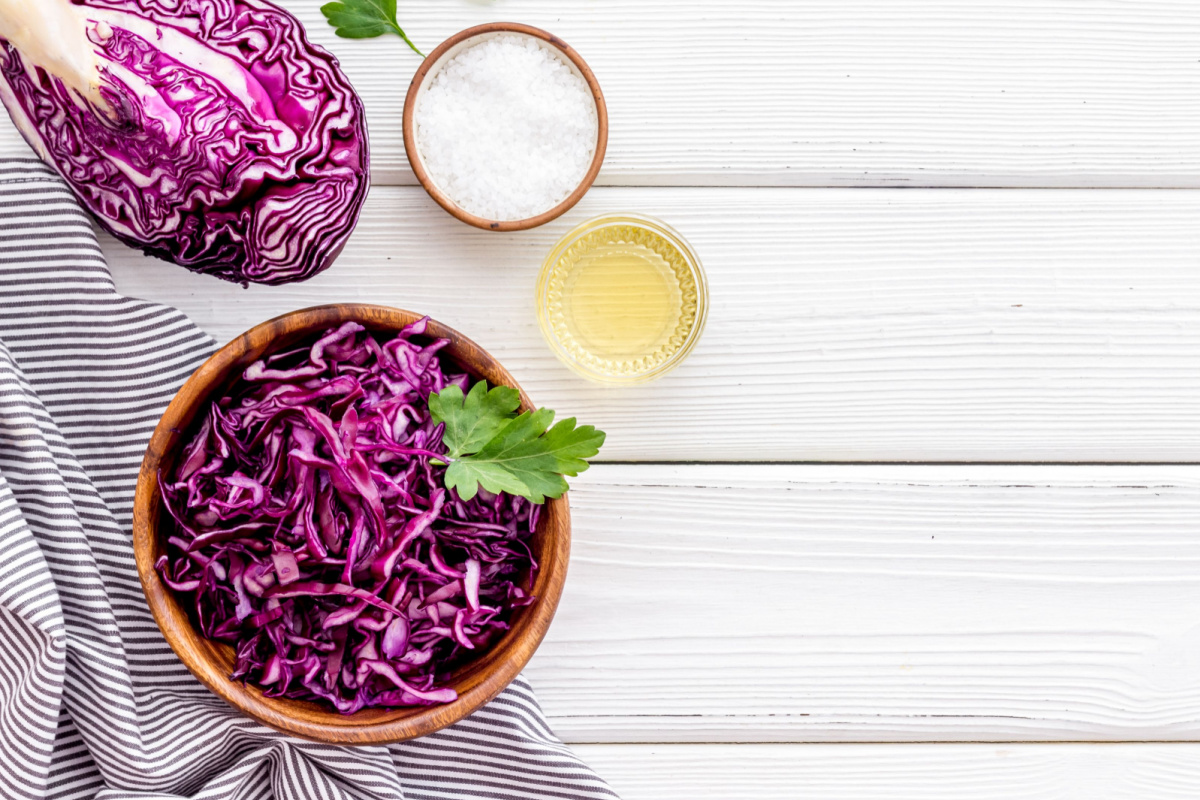Cool, Crunchy, Colorful Coleslaw

Fun-Da-Mentals Kitchen Skills
- measure :
to calculate the specific amount of an ingredient required using a measuring tool (like measuring cups or spoons).
- pour :
to cause liquid, granules, or powder to stream from one container into another.
- slice :
to cut into thin pieces using a sawing motion with your knife.
- whisk :
to beat or stir ingredients vigorously with a fork or whisk to mix, blend, or incorporate air.
Equipment Checklist
- Mixing bowl
- Cutting board
- Kid-safe knife
- Measuring spoons
- Whisk
- Wooden spoon or spatula
Ingredients
Cool, Crunchy, Colorful Coleslaw
- 5 to 6 romaine lettuce leaves
- 3 to 5 purple cabbage leaves
- 3 to 4 red radishes
- 1 T vinegar
- 1 T olive oil
- 2 tsp granulated sugar/agave syrup/honey
- 1 big pinch salt
- 1 T plain yogurt or sour cream, optional **(for DAIRY ALLERGY sub dairy-free/nut-free plain yogurt or sour cream)**
Food Allergen Substitutions
Cool, Crunchy, Colorful Coleslaw
- Dairy: Substitute dairy-free/nut-free plain yogurt or sour cream.
Instructions
Cool, Crunchy, Colorful Coleslaw
slice + combine
Slice 5 to 6 romaine lettuce leaves, 3 to 5 purple cabbage leaves, and 3 to 4 red radishes and combine in a mixing bowl.
measure + whisk
Measure and add 1 tablespoon vinegar, 1 tablespoon olive oil, 2 teaspoons sugar, and 1 big pinch of salt and whisk.
pour + mix
Pour this dressing over the sliced vegetables and mix. Let stand for at least 10 to 15 minutes to let vegetables marinate and serve on top of the sautéed jackfruit or sweet potato in Jumping Jackfruit (or Sweet Potato) BBQ Sliders.

Hi! I'm Cabbage!
"I come in a few different colors and shapes, but I'm usually green or red (which is really purple-red) with tightly packed leaves forming a round head. You may be most familiar with me shredded in coleslaw and cooked for a St. Patrick's Day dinner with corned beef."
- Cabbage was likely domesticated before 1000 BCE in Europe, and the ancient Egyptians, Greeks, and Romans used it in their cuisines. Cabbage was introduced to Asia and the Americas sometime between the 1500s and the 1700s and was considered a staple food in Europe by the 18th century.
- China produces the most cabbage worldwide, but Russia consumes the most per person.
- The word "cabbage" is late Middle English from the Old French (Picard dialect) "caboche" ("head"), a variant of Old French "caboce."
- Cabbage has many relatives (broccoli, cauliflower, brussels sprouts, collard greens). All of these vegetables are part of a family called "Brassica."
- The cabbage head grows in the center of a cabbage plant. Initially, the plant produces large, broad leaves, but eventually, the inner leaves begin to curl around a short, thick stem at the center. These inner leaves form the head of cabbage we see in markets.
- Green cabbage is the most common type. It has thick green leaves that are packed close together in the head. One head can weigh from one pound to nine pounds! You can cook it as a standalone veggie, add raw cabbage to coleslaw, use it to make cabbage rolls, or add it to soups and stews.
- There are a few varieties of green cabbage, including the pointed cabbage, which is shaped like a cone! Savoy cabbage is a smaller, milder variety with tender, wrinkly leaves that you can use to make cabbage rolls or add to salads and stir-fries.
- Red cabbage is popular in coleslaw and salads because of its color and crunchy texture. You can also pickle red cabbage to serve as a condiment to top burgers or tacos, or serve it as a side, especially with German dishes.
- White cabbage comes from the Netherlands and is also called Dutch cabbage. It is a type of green cabbage with very pale green to white leaves, although there is also a red variety. The Dutch variety is good for making sauerkraut, although you can also use it in the same way as green and red cabbage.
- Napa cabbage, also called Chinese cabbage, is oblong with light green and yellow leaves and has a long, thick, and crunchy stem. It has a mild flavor and is popular in Asian cuisine in soups, spring rolls, stir-fries, and as wraps for pork and seafood.
- Cabbage is high in fiber and vitamins C and K. Vitamin K is good for the blood. A cup of raw cabbage has more vitamin C than an orange!
- Different varieties of cabbages have varying nutritional strengths. For example, red cabbage has more vitamins C and B6 and antioxidants called anthocyanins that help keep your heart healthy, while the green savoy has more vitamins A and B9 (folate).
- Cabbage and other cruciferous vegetables are rich sources of phytochemicals, naturally-occurring plant chemicals that may protect people against some forms of cancer.
History of Coleslaw!

- Coleslaw or just "slaw" is a salad made from a "cole" plant of the Brassica species, like broccoli, cabbage, and kale.
- The word "coleslaw" came from the Dutch "koolsla," from "kool" for "cabbage" + "sla" (shortened from "salade") for "salad."
- A 1770 Dutch cookbook, The Sensible Cook, has a recipe with thin strips of cabbage, melted butter, vinegar, and oil. Common ingredients today are shredded cabbage, shredded carrots, onion, sugar, and black pepper, dressed with vinaigrette or mayonnaise and cider vinegar.
- You can eat coleslaw alone as a side salad, popular at picnics and potlucks. You can also put it on a sandwich, like a barbecue pulled pork sandwich. The Rachel sandwich, a counterpart of the Reuben sandwich, has coleslaw instead of sauerkraut and turkey or chicken instead of corned beef.




